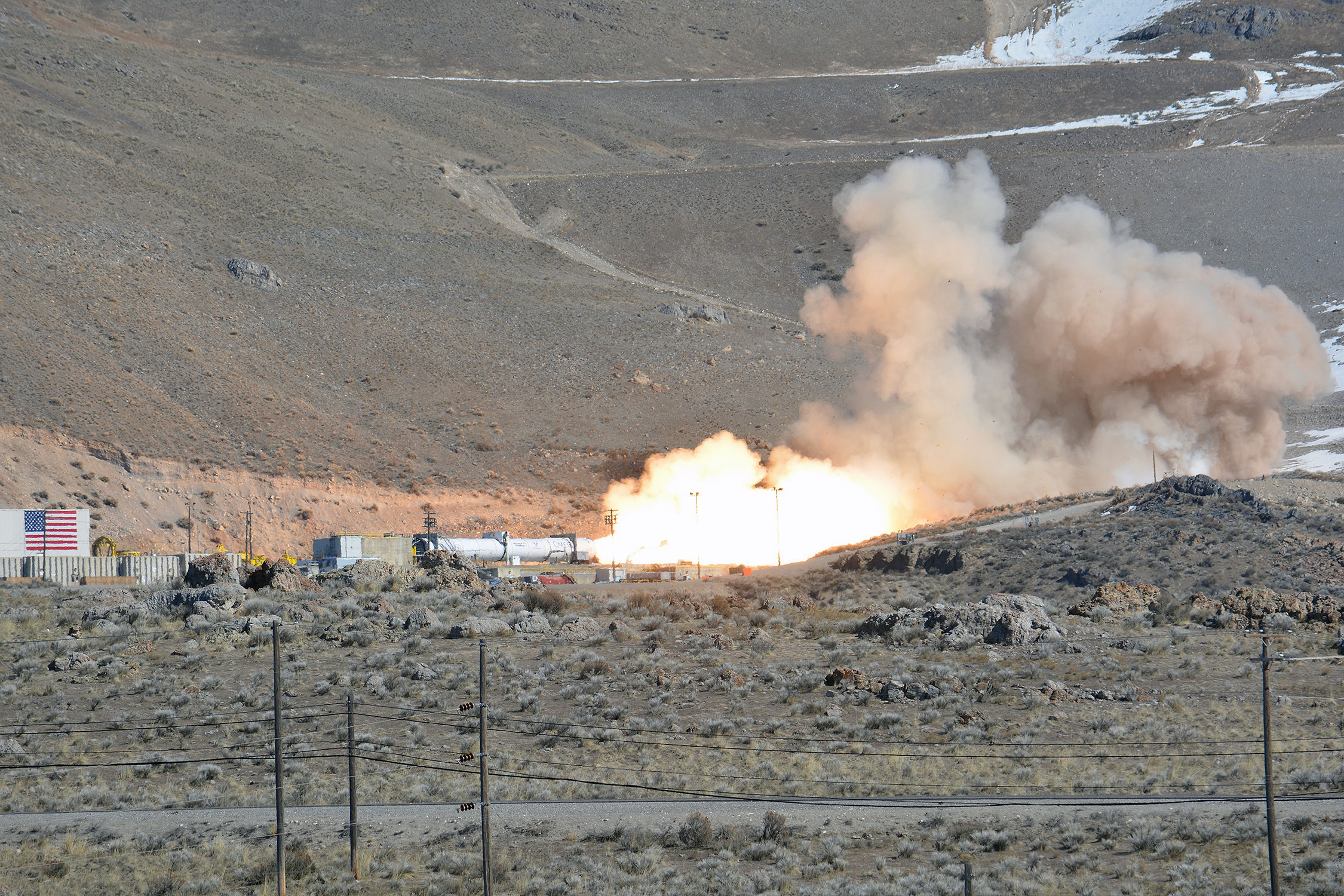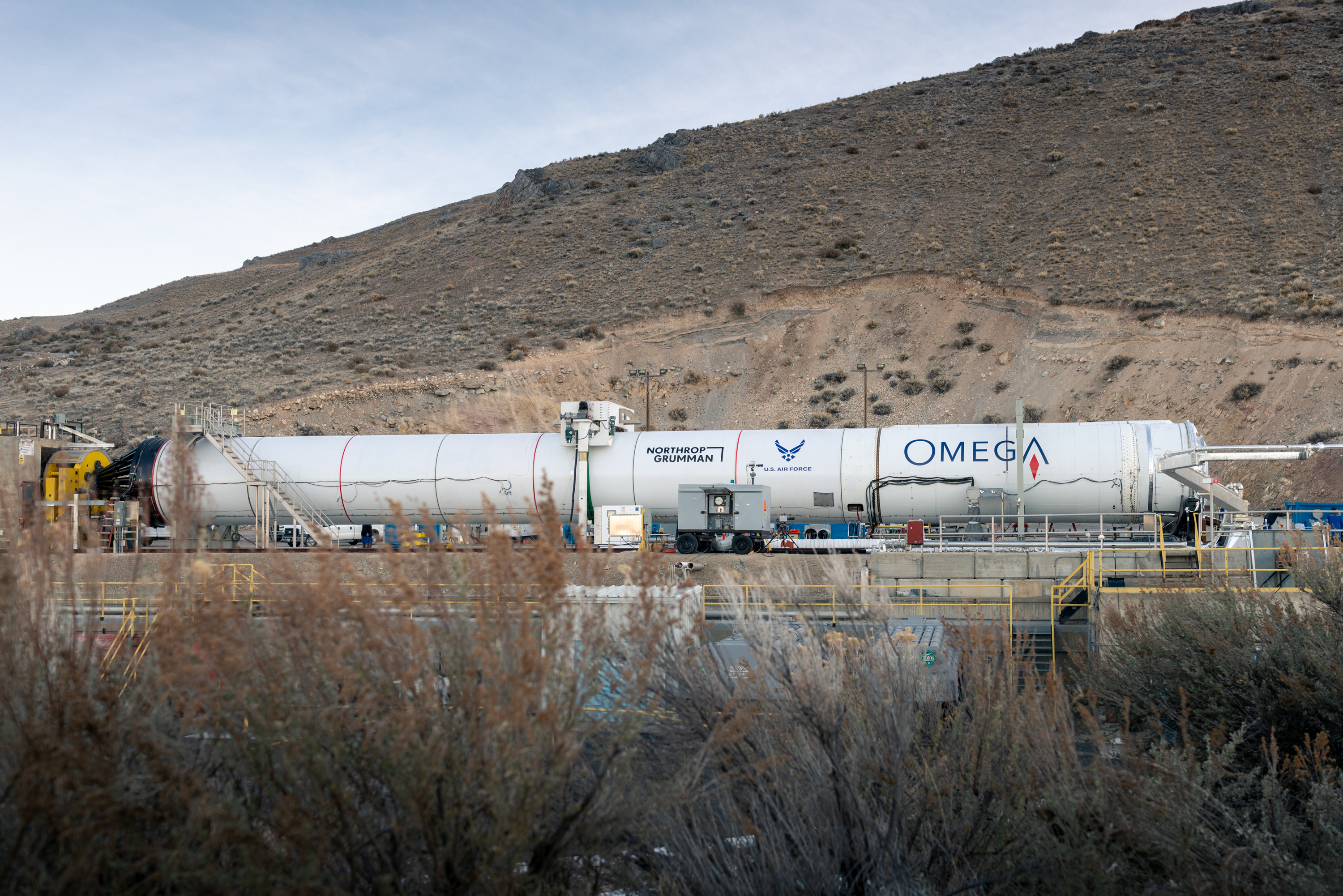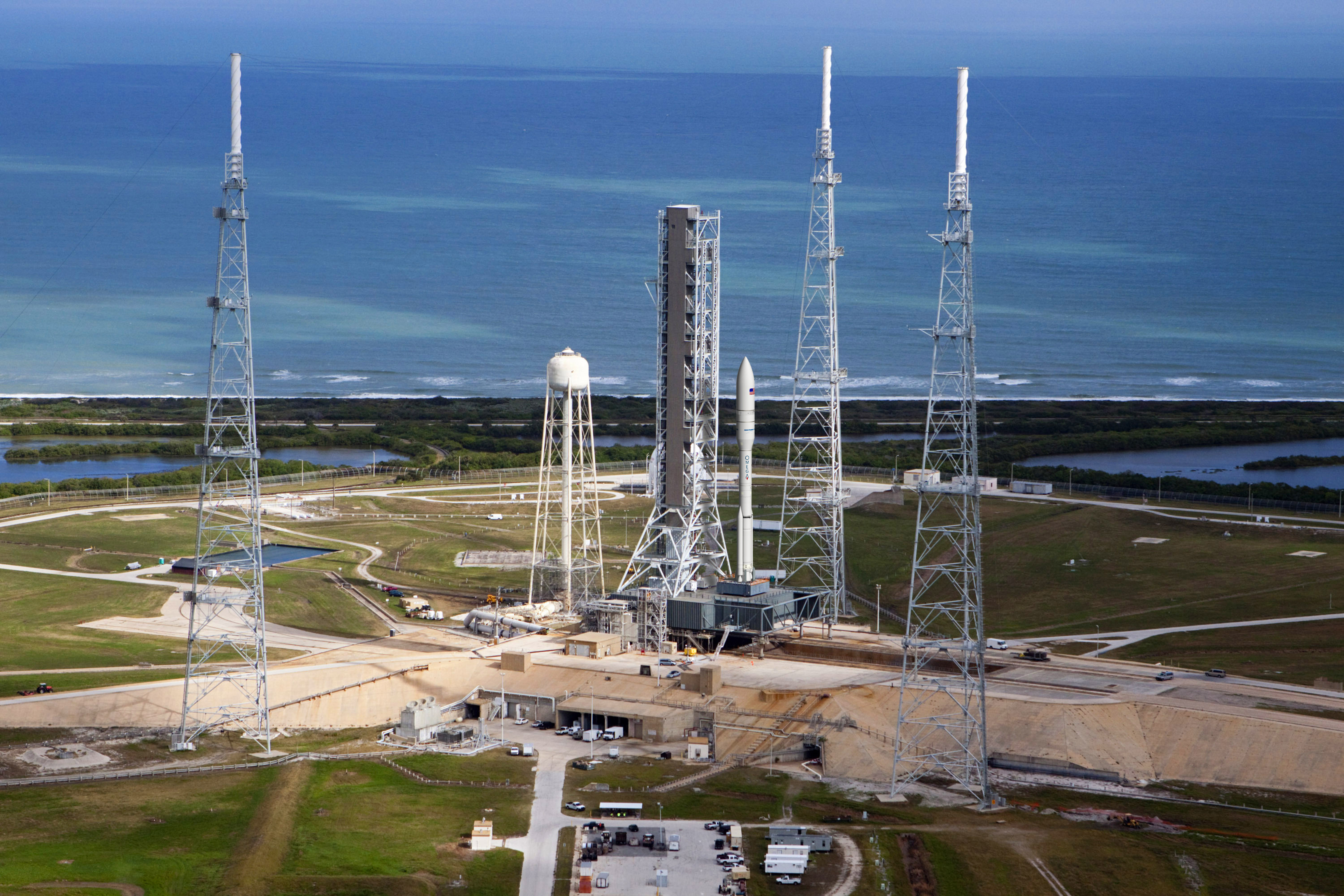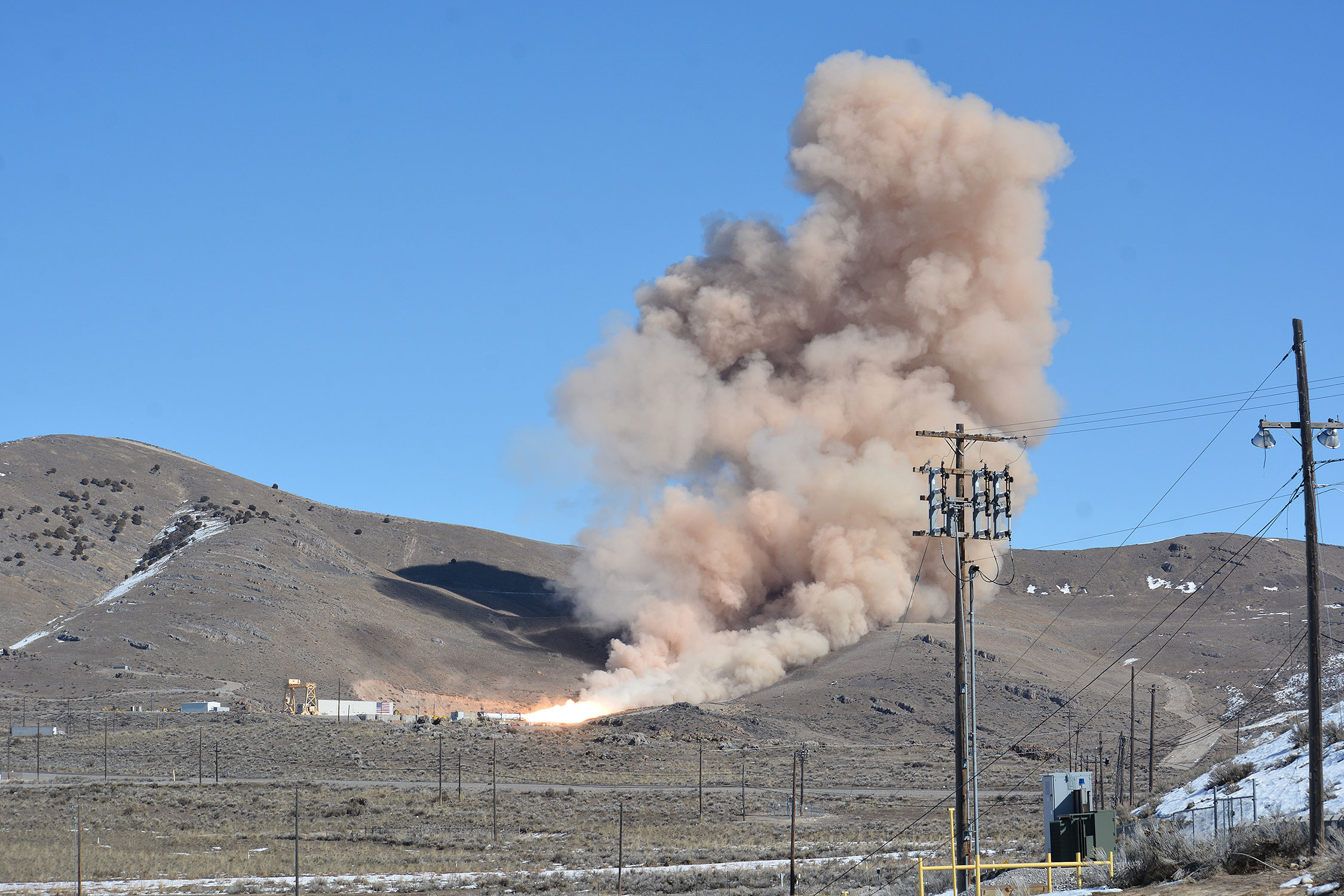Northrop Grumman test fires new OmegA rocket second stage motor in Utah
PROMONTORY, Utah — A new rocket's second stage roared to life for the first time today (Feb. 27), sending flame and smoke billowing out against the snow-capped mountains of Utah.
Mounted on a horizontal test stand at Northrop Grumman's Promontory propulsion facility, the Castor 300 solid-fuel motor was fired for about 139 seconds, the same amount of time — within a second or two — that it will burn in flight as the second stage of the company's new OmegA rocket. The 1:05 p.m. MST (3:05 p.m. EST or 2000 GMT) demonstration was witnessed by about 500 people, including Northrop Grumman employees, local high school students and members of the surrounding communities.
The so-called static test followed a similar firing of the OmegA's Castor 600 first stage in May 2019. With both tests complete, and today's static fire appearing to have been successful, Northrop Grumman remains on track for a maiden OmegA launch from NASA's Kennedy Space Center in Florida in spring 2021.
Related: 3 new rockets are on track for 1st test flights in 2021
"I talked to the program managers who were in the bunker and thrust trace looks really good, time of burn looks really good and the nozzle vectoring was spot on, so, so far, the very preliminary conditions looked exactly like what we wanted. Good news," Charlie Precourt, vice president and general manager for propulsion systems at Northrop Grumman Innovation Systems and a former NASA astronaut, told reporters after the test was conducted.
Northrop Grumman is building OmegA to launch U.S. national security missions. In 2018, the U.S. Air Force awarded the company a $792 million launch services agreement to advance the rocket's development through the first flights of its intermediate and heavy configurations.
The company is now waiting to learn if OmegA will be among the Air Force's selection of launch service providers for missions beginning in 2022, in a competition with Blue Origin, SpaceX and United Launch Alliance. That decision, worth billions of dollars, is expected to come next year.
Breaking space news, the latest updates on rocket launches, skywatching events and more!
Common boost segment
The Castor 300 motor with its composite-wound case is central to Omega's design.
"Because of the Air Force's demanding mission for a variety of different orbits with different payload sizes, we wanted to build something that could, with modular variants on configuration, capitalize on the similarity of a common segment. And so that common segment is known as the Castor 300 — 300 represents the mass of the propellant, 300,000 pounds [136,000 kilograms]," Precourt told Space.com in an interview.
In its intermediate configuration, the OmegA uses a double segment (the Castor 600) as its first stage. In its more powerful, heavy variant, that stage is comprised of four common segments (Castor 1200). Both versions use a single common segment (Castor 300) as a second stage, Northrop Grumman GEM strap-on boosters and a liquid-fuel upper stage powered by two Aerojet Rocketdyne RL-10 engines.
"The [Castor] 600 and 300 represent the replacement of the RD-180, which was the primary objective [of the Air Force] for the first part of this development program," Precourt said, referencing the Russia-sourced rocket engine that currently powers the United Launch Alliance (ULA) Atlas V first stage. "With this test Thursday, we have completed that basic requirement to match or exceed, and in our case, we are exceeding the performance capabilities."
Objectives intact
Though comprised of the same common boost segment, the tests of the Castor 600 in 2019 and the Castor 300 differed in some key ways.
For one, because of its shorter length (41.6 feet, or 12.69 meters, versus 72 ft or 22 m), the Castor 300 was mounted to more inert shuttle-legacy, Space Launch System (SLS) steel cases to adapt to the test stand.
The OmegA will need to launch in different climates depending on the time of year or from where it will launch (in addition to using NASA's Pad 39B in Florida, Northrop Grumman also plans to use Space Launch Complex-6 at Vandenberg Air Force Base in California for OmegA launches). To prepare for this, the static test for the first stage was a "hot" test. The vehicle was conditioned prior to firing to be at 90 degrees Fahrenheit (32 degrees Celsius). The Castor 300 test was "cold"; the vehicle was conditioned at 40 degrees F (4 degrees C).
The tests also differed based on how each stage was designed to throttle while firing. Solid rocket motors are throttled by changing the way the propellant is cast in the segment. The more surface area exposed at any given time, the more thrust is generated.
"One of the things we need to do is demonstrate that the design meets what we have required of it," Precourt explained.
In total, the Castor 300 test had 11 primary objectives, including validating the performance of the motor, measuring insulation performance and measuring the thermal and strain data on the case and nozzle structural components.
At the end of the 122-second Castor 600 test in May 2019, the aft exit cone of the stage's nozzle unexpectedly broke apart. Post-test analysis showed that a pressure differential between the push of the atmosphere on the outside of the nozzle and the pull from the inside the segment resulted in the nozzle failing. Had the vehicle been in flight, at 18,000 feet (5,500 m) where the atmospheric pressure is less, the issue would likely not have occurred.
"So, we just needed to beef up the stiffness at the tail end of the nozzle," said Precourt. "We got that well under control, and it was a fairly straightforward thing to correct."
From here to launch
Today's test clears the way for Northrop Grumman to proceed toward its first launch of the OmegA rocket.
"With a successful test Thursday, we have achieved what we need to for the first certification flights from the standpoint of the [Castor] 300 and the 600. There are some ongoing subsequent tests of certain aspects of the stages that will go on, but they are second order kinds of things. What is more important is we move into assembly and preparation for launch," Precourt told Space.com.
The first and second stages for the first flight will be prepared in Promontory and then moved by rail to the Kennedy Space Center later this year. In August 2019, Northrop Grumman took over the use of a high bay in NASA's Vehicle Assembly Building, as well as a space shuttle-era mobile launch platform (MLP) to support OmegA launch operations. Construction of a launch tower on the MLP is currently underway.
OmegA's liquid-fuel upper stage is being fabricated at the Michoud Assembly Facility in New Orleans. Once ready, it will be shipped to NASA Glenn Research Center's Plum Brook Station in Ohio, where it will undergo its own test fire in a vacuum chamber before being delivered to the Cape for integration with the Castor segments.
In December 2019, Northrop Grumman announced the selection of Saturn Satellite Networks to provide up to two satellites to fly on the first launch.
Two OmegA intermediate configuration certification flights are planned for 2021. An additional two flights to certify the heavy variant of the rocket are planned to follow in the 2024 timeframe. Two more static fires of the Castor 300 and 600 are also planned for 2021.
Disclosure: Northrop Grumman underwrote travel expenses for Space.com to provide coverage of the Omega second stage static fire.
- Apollo to OmegA: NASA signs over legacy launcher for new rocket
- NASA's 1st SLS megarocket core loaded onto barge ahead of key engine test
- Firefly Aerospace rocket engine test ends in fire (video)
Robert Pearlman is a Space.com contributing writer and the editor of collectSPACE.com, a Space.com partner site and the leading space history news publication. Follow collectSPACE on Facebook and on Twitter at @collectSPACE. Follow us on Twitter @Spacedotcom and on Facebook.
OFFER: Save at least 56% with our latest magazine deal!
All About Space magazine takes you on an awe-inspiring journey through our solar system and beyond, from the amazing technology and spacecraft that enables humanity to venture into orbit, to the complexities of space science.

Robert Pearlman is a space historian, journalist and the founder and editor of collectSPACE.com, a daily news publication and community devoted to space history with a particular focus on how and where space exploration intersects with pop culture. Pearlman is also a contributing writer for Space.com and co-author of "Space Stations: The Art, Science, and Reality of Working in Space” published by Smithsonian Books in 2018.
In 2009, he was inducted into the U.S. Space Camp Hall of Fame in Huntsville, Alabama. In 2021, he was honored by the American Astronautical Society with the Ordway Award for Sustained Excellence in Spaceflight History. In 2023, the National Space Club Florida Committee recognized Pearlman with the Kolcum News and Communications Award for excellence in telling the space story along the Space Coast and throughout the world.





